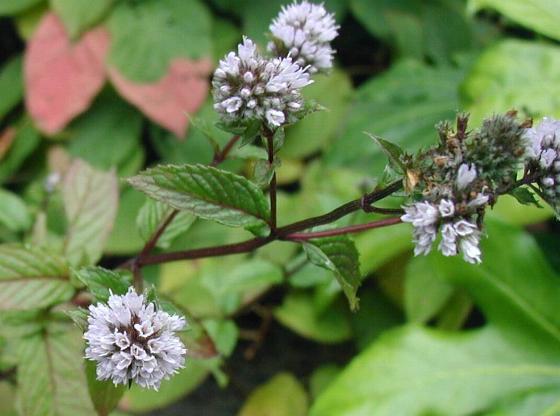Mint
(Mentha viridis) Spearmint, a member of the Labiatæ, is a very hardy perennial, native to Mediterranean countries. Its generic name is derived from the mythological origin ascribed to it. Poets declared that Proserpine became jealous of Cocytus’s daughter, Minthe, whom she transformed into the plant. The specific name means green, hence the common name, green mint, often applied to it. The old Jewish law did not require that tithes of “mint, anise and cumin” should be paid in to the treasury, but the Pharisees paid them while omitting the weightier matters, justice, mercy, and faith (Matthew xxiii, 23). From this and many other references in old writings it is evident that mint has been highly esteemed for many centuries. In the seventeenth century John Gerarde wrote concerning it that “the smelle rejoyceth the heart of man.” Indeed, it has been so universally esteemed that it is found wild in nearly all countries to which civilization has extended. It has been known as an escape from American gardens for about 200 years, and is sometimes troublesome as a weed in moist soil.
Description: From creeping rootstocks erect square stems rise to a height of about 2 feet, and near their summits bear spreading branches with very short-stemmed, acute-pointed, lance-shaped, wrinkled leaves with toothed edges, and cylindrical spikes of small pink or lilac flowers, followed by very few, roundish, minute, brown seeds.
Cultivation: The plant may be easily propagated by means of cuttings, offsets and division in spring. They may be expected to yield somewhat of a crop the first season, but much more the second. In field culture they will continue profitable for several years, provided that each autumn the tops are cut off near the ground and a liberal dressing of manure, compost or even rich soil is given. In ordinary garden practice it is well also to observe this plan, but usually mint is there allowed to shift for itself, along with the horseradish and the Jerusalem artichoke when such plants are grown. So treated, it is likely to give trouble, because, having utilized the food in one spot, its stems seek to migrate to better quarters. Hence, if the idea is to neglect the plants, a corner of the garden should be chosen where there is no danger of their becoming a nuisance. It is best to avoid all such trouble by renewing or changing the beds every 5 or 6 years.
Mint will grow anywhere but does best in a moist, rich loam and partial shade. If in a sheltered spot, it will start earlier in the spring than if exposed. Upon an extensive scale the drills should be 2 inches deep and 12 to 15 inches apart. Bits of the rootstocks are dropped at intervals of 6 to 12 inches in the rows and covered with a wheel hoe. For a new plantation the rootstocks should be secured when the stems have grown 2 or 3 inches tall.
For forcing, the clumps are lifted in solid masses, with the soil attached, and placed in hotbeds or forcing house benches. Three or four inches of moist soil is worked in among and over them and watered freely as soon as growth starts. Cuttings may be made in two or three weeks. Often mint is so grown in lettuce and violet houses both upon and under the benches. During winter and spring there is enough of a demand for the young tender stems and leaves to make the plants pay. It is said that the returns from an ordinary 3 x 6-foot hotbed sash should be $10 to $15 for the winter. For drying, the stems should be cut on a dry day when the plants are approaching full bloom and after the dew has disappeared in the morning. They should be spread out very thinly in the shade or in an airy shed. If cut during damp weather, there is danger of the leaves turning black.
Uses: In both the green and the dried state mint is widely used in Europe for flavoring soups, stews and sauces for meats of unpronounced character. Among the Germans pulverized mint is commonly upon the table in cruets for dusting upon gravies and soups, especially pea and bean purees.
In England and America the most universal use of mint is for making mint sauce, the sauce par excellence with roast spring lamb. Nothing can be simpler than to mince the tender tops and leaves very, very finely, add to vinegar and sweeten to taste. Many people fancy they don’t like roast lamb. The chances are that they have never eaten it with wellmade mint sauce. In recent years mint jelly has been taking the place of the sauce, and perhaps justly, because it can not only be kept indefinitely without deterioration, but because it looks and is more tempting. It may be made by steeping mint leaves in apple jelly or in one of the various kinds of commercial gelatins so popular for making cold fruit puddings. The jelly should be a delicate shade of green. Of course, before pouring into the jelly glasses, the liquid is strained through a jelly bag to remove all particles of mint. A handful of leaves should color and flavor four to six glasses full.


